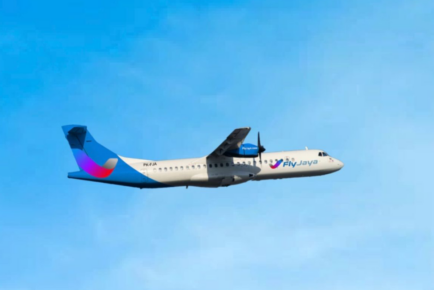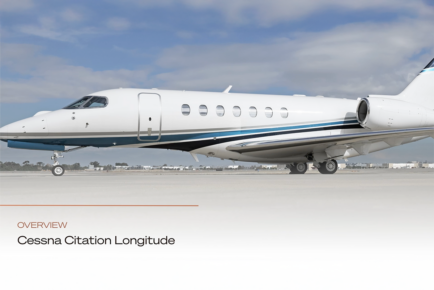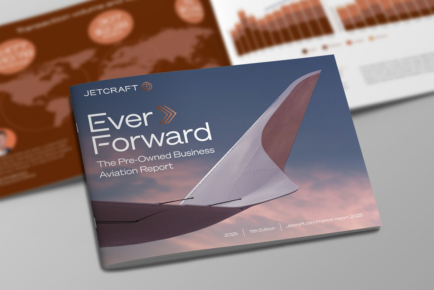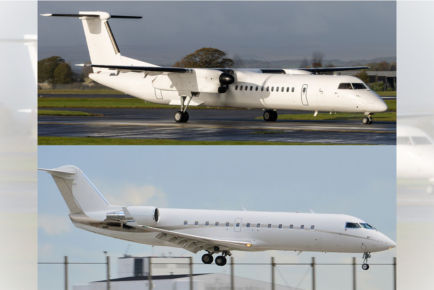
AvBuyer Magazine, April 2015
by Ken Elliott
Download a PDF of the article.
Helping you to familiarize with avionics advances and related mandates for equipage, Ken Elliott reviews aviation technologies within the NextGen/SESAR architecture, this month focusing on ADS-B.
In line with domestic and international aviation goals, industry and certification authorities have developed a complete suite of integrated technologies under the umbrella of Communication, Navigation and Surveillance (CNS). One significant element of this, under the Surveillance segment, is Automatic Dependent Surveillance (ADS).
As the term implies, ADS serves the need to automate the sharing of data between all users, air and ground, that inform the position and movement status of an aircraft. There are two ways to accomplish this from a worldwide perspective, one being Broadcast (B) and the other Contract (C), hence the terms ADS-B and ADS-C.
Broadcast is literally the ability to send and receive the data via line of sight or within the range capability of the higher frequencies used. Contract, on the other hand, means the ability to handshake and pass on the same data within areas where an out-of-range condition may exist. This is where the use of satellites comes into play. The satellite(s) and corresponding service providers, become the enabler for those large open oceanic spaces. ADS-C can also be the transcontinental means of sharing the data for enroute ATC datalink, and may be facilitated by VHFbased ACARS.
The interplay between ADS-B and FANS may be a bit confusing. The previous article of this series covered FANS and included ADS-C. To refresh and clarify, the connection between ADS-B and FANS is the use of datalink communication methods as a conduit for surveillance data, normally part of ADS-B.
The ADS-C component of ADS is where, using the aircraft FANS 1/A Satcom, a contract is created between the Operator, Satcom service provider and ATC to automatically make available the surveillance data from your aircraft while receiving data from others. The pilot is not normally in the loop. The originating aircraft, ATC and other aircraft within a given region are in the loop all the time, constantly updating at far better rates than the existing primary radar.
Moving to the next level, the system has the ability to send and the separate ability to receive. The send ability is ADS-B Out (the only part of ADS-B currently under mandate). The receive ability, or ADS-B In, is not yet mandated and therefore optional. However, a lot of the work around ADS-B is centered on In Trail Procedures (ITP) where aircraft can make requests and be guided through efficient flight level changes as leading or paralleling other aircraft. ADS-B In is required for this advanced primarily oceanic airspace tool. ADS-B In is also to be used for aircraft separation needs. ADS-B In can further provide pilot notices and weather (especially useful to GA).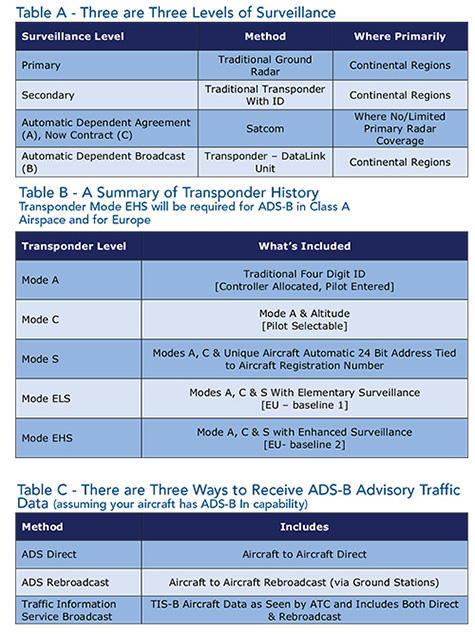
One of the most significant benefits of FANS is the mitigation of the need for primary surveillance radar. Air Traffic Control (ATC) using ADS-B or -C can ‘see’ the same or better than the limited coverage and reliability of radar. In fact historically, as Table A shows, there are three levels of surveillance. Today we are fast moving into the third level of fully automated, global and more frequently updated surveillance.
Remember: For ADS-B In users, the information provided by ADS-B is always advisory only and never replaces the Out The Window (OTW) view or ATC instructions. ADS-B should be seen as another tool in the cockpit toolkit.
US ADS-B
On January 1, 2020 the FAA will require all aircraft operating in US airspace above 10,000 ft to be ADSB Out equipped. So you have from now until the end of 2019 to comply. This airspace requirement follows the Mode-C transponder requirement currently in use for many years.
There are new considerations for light sport aircraft and some less restrictive GPS requirements in the works for legacy commercial operators that are lessening the all-embracing rule regarding ADS-B. Expect some other easing between now and 2020. The closer we are to the deadline the more breathing space may be provided, but for most it is likely that nothing will change. For most business jet operators, the Class A airspace portion of the rule will apply and that means different equipage requirements to anyone flying in Class E airspace.
Unique to the US, there are two ways to equip (see Equipage). For Part 25 aircraft, equipage for Class A is sufficient, but to receive the free weather information provided on a different frequency with wider broadband capable of graphic transmission, it is recommended to include a Universal Access Transceiver (UAT).
Traffic Information Service–Broadcast (TIS-B) and Flight Information System–Broadcast (FIS-B) define free surveillance, weather and airspace notification information available to pilots. TIS-B also allows non- ADS-B transponder equipped aircraft being tracked by radar to have their location and track information broadcast to ADS-B equipped aircraft.
To the credit of the FAA all ADS-B ground stations are in place as of late 2014. There are some interoperability issues in work, but all should be fully activated and interactive before 2020. Currently ADS-B Transceivers are able to “wake up” the US ADS-B ground stations, triggering them to transmit traffic data to aircraft within a local area. If equipped with ADS-B In, an aircraft can now display this transmitted information in the US. Those with the UAT and dedicated display can also receive weather information that is always available as FIS-B from ADS-B ground stations.
To better serve the wider aviation community, address concerns and resolve ADS-B system-wide technology issues, the FAA has created an industrywide collaborative work group called FAA Equip 2020. The first call to action meeting was held in October 2014. Also under the auspices of RTCA SC 186, the FAA is progressing with further ADS-B guidance currently centered on interval management.
International ADS-B
ADS-B Out coverage is available, or in work, in several worldwide locations, with Australia being ahead of the pack. Coverage can also be found in Hong Kong, Singapore, Hudson Bay and Indonesia. Canada beyond Hudson Bay, Sweden and China are ramping up fast with ground stations.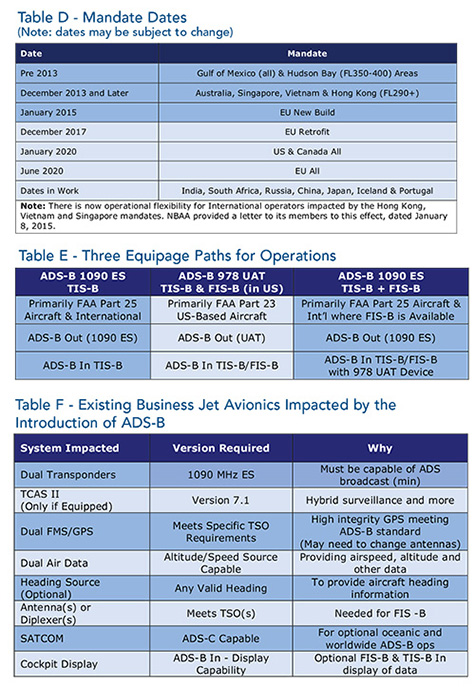
Equipage
What drives equipment requirements are the Technical Standard Orders (TSOs). These are C154c (Universal Access Transceiver) and TSO-C166b (1090 ES). Remembering that to operate in Class A airspace, or in the European Union and across the world, equipment standard requirements must be at the level of TSO-C166b.
Not only may new equipment be required for your aircraft to comply with ADS-B requirements, but existing equipment may need to be upgraded or modified (see Table F).
Because ADS-B requires a Type Certificate (TC) or a Supplemental Type Certificate (STC), for jet aircraft it is recommended that the aircraft OEM be consulted where a TC or STC is involved. Consult an MRO if the issues involve only STCs. Often there are bundled packages that include FANS and CPDLC upgrades available to operators. Sometimes only part of the work can be accomplished based on pending certifications on launch aircraft.
Because of budgets, existing aircraft equipage, downtime limitations and operational needs, no one OEM or MRO solution fits all issues for any one type of aircraft.
Remember, as is usually the case the newer the aircraft, the less of an upgrade will likely be needed. This impacts downtime, of course, with out of service times being estimated from a few days to several weeks. As with many major modifications, if you are advised a longer downtime will be required you should plan to combine work with a major inspection, interior rework or an add-on to repaint. Combining aircraft access costs across multiple work tasks can be a significant saving and less risk for hangar rash.
Importantly: for everyone reading this article, if you have not completed ADS-B STC/TC upgrades, modifications or service bulletins and they are available to you today, this is the time to plan, schedule and perform. You will be glad you did!
In 1998 aircraft owners were ramping up for TCAS, TAWS, ELT and RVSM, all with steadily approaching mandates. The demand to schedule into overworked shops was exponential in the extreme. Shops hired unfamiliar contract workers to support that surge in business, while costs to complete the work rose significantly. This created a difficult customer-MRO situation across the US, and probably elsewhere, where loyalties were strained and stories of late aircraft deliveries abounded. Certification delays for STCs further exacerbated the situation. Are we headed for a similar situation today?
By January 2015 there were 9,064 out of a ballpark of 150,000 aircraft equipped to meet Automatic Dependent Surveillance mandates. It is further estimated that around 20% of those aircraft do not properly comply with equipment performance requirements. Some issues include air-ground determination and Baro/Geo altitude, ICAO 24 bit address, transponder codes and flight ID errors. Do not assume that waiting for an upgrade will remove the risk of these errors on your aircraft. Errors by overworked shops will mitigate any gains from resolutions to current issues.
Lastly on equipage, do not assume costs will come down, that mandates will be delayed or that experience on other aircraft will make it less risky on yours. All of these assumptions have been proven wrong over and over in the avionics world, with only certain exceptions (like a tendency for Europe to delay or realign requirements).
Easily accessible FAA and EASA guidance for equipage and operations can be found in:
• FAA AC 20-165A – ADS-B Out installation guidance
• FAA AC 20-172A – ADS-B In installation guidance
• FAA AC 20-149A – FIS-B installation guidance
• FAA AC 90-114A (Updated Oct 2014) – ADS-B Operations as well as InFO 13009 for Ops Specs and LOA
• EASA AMC 20-24 – ADS-B Certification Considerations. (Many countries outside of EU use this standard).
Be Careful!
Ensure that your equipage meets the standards and requirements set by the country in which you are registering and operating your aircraft. Remember that the region where you fly takes precedence with respect to compliance, and there are differences in equipage requirements set by different certification regions. Work with your OEM or MRO to ensure compliance requirements are fully met. This becomes a factor when trading aircraft, especially as we arrive closer to the 2020 deadlines.
One area worthy of mention for US operators is the availability of funding for NextGen. The NextGen GA Fund via Nexa Capital Partners and the Aircraft Electronics Association (AEA), is available to operators of business jets. Recently it was announced that L3 Aviation has a low cost ADS-B Out/In equipage solution available through this funding that offers favorable terms to borrowers.
Access to funding is via the Aircraft Electronics Association (AEA), whose members are able to arrange financing for operators via web portals. When talking to your OEM or MRO mention this available resource. Most shops are long-standing members of AEA, a trustworthy and very active organization representing the avionics industry worldwide.
Benefits of ADS-B
• Traffic avoidance advisory both laterally and vertically.
• Surveillance in the vast area without primary radar coverage as well as oceanic via ADS-C in areas without primary or secondary radar coverage.
• Display of real-time traffic in the cockpit.
• Another enhancement to safety using automatic traffic call-outs, including surface runway incursion warnings.
• Reduction of separation with greater predictability in departure and arrival times.
• With an eventual wide migration of airspace users, including ground vehicles, the real benefits of ADS-B will be realized.
Are you looking for more articles on avionics? Visit www.avbuyer.com/articles/category/business-aviation-avionics/
❯ Ken Elliott is a highly-respected industry authority on avionics as a member of the NextGen Advisory Council sub-committee and Technical Director, Avionics at Jetcraft. Contact Ken via [email protected] or www.www.jetcraft.com.
This article was written by Ken Elliott, Jetcraft Avionics – Technical Director, for AvBuyer Magazine. It was published in the April 2015 issue. Click here to view the Digital issue of the April AvBuyer or to view Archived editions.
Contrail photo courtesy of Chris Hsia on Flickr.
Some Useful Reference Sources
EUROCONTROL – Skyways publication
EUROCONTROL – Skybrary publication Mode S & ADS-B w/Mode S video demonstration
ICAO – GOLD (Global Operational Data Link Document)
NBAA – under Aircraft Operations (CNS and International Ops)
SIGN UP FOR OUR MONTHLY JETSTREAM RECAP
Don't miss future Jetstream articles. Sign up for our Jetcraft News mailing list to receive a monthly eblast with links to our latest articles. Click to join the 1,800+ subscribers on our mailing list.

